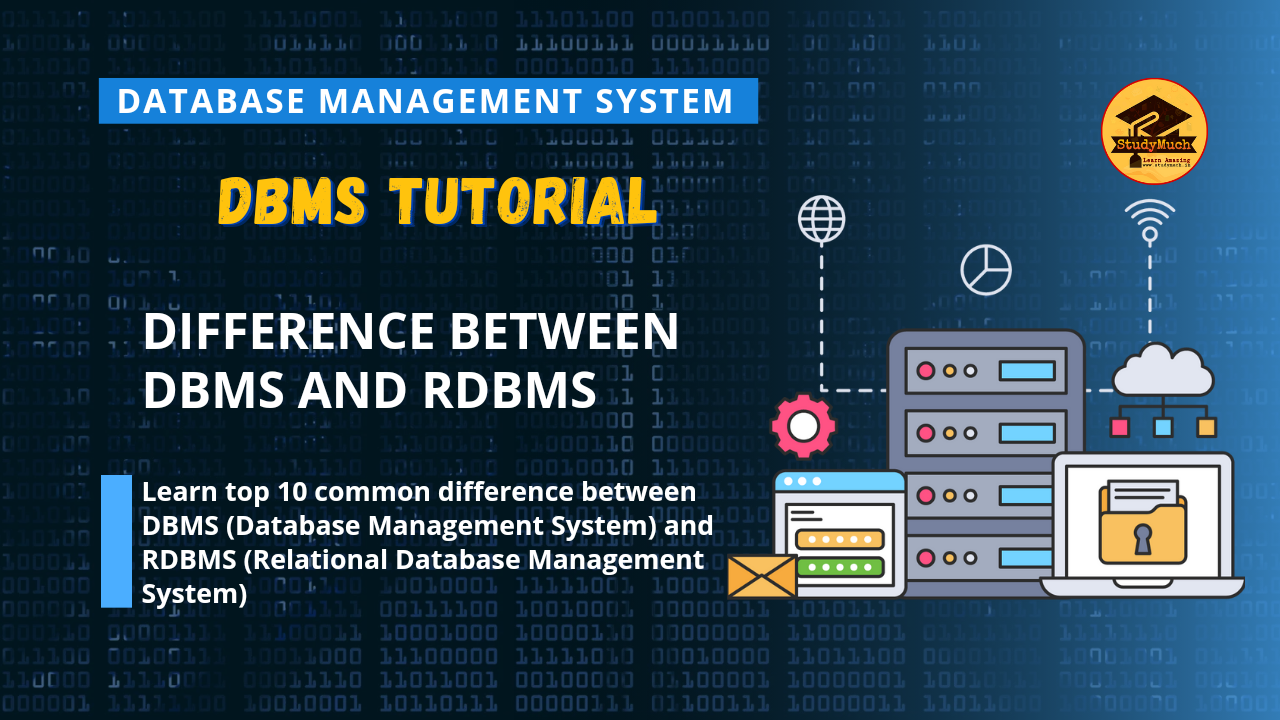Different Between DBMS and RDBMS

Different Between DBMS and RDBMS
In this tutorial you will learn different between DBMS and RDBMS. Here we provide you top common differences between DBMS and RDBMS. And also provide the best definition of both DBMS and RDBMS.
What is DBMS?
DBMS stands for Database Management System. It is a software application that allows users to manage, store, retrieve, and manipulate data in a database. A database is a collection of organized data, typically stored in a computer system, which can be accessed and managed in various ways.
Some popular examples of DBMSs include MySQL, Oracle Database, Microsoft SQL Server, PostgreSQL, and MongoDB, among others. DBMSs can use different data models, such as relational, hierarchical, network, or object-oriented, and can be used in different types of databases, such as relational databases, NoSQL databases, and more.

What is RDBMS?
RDBMS stands for Relational Database Management System. It is a type of DBMS that is based on the relational data model, which organizes data in a tabular format with rows and columns, and establishes relationships between tables using keys. RDBMSs are the most widely used type of DBMS for managing structured data.
In an RDBMS, data is organized into tables, where each table represents a collection of related data with a predefined structure. Each row in a table represents a single record, and each column represents a specific attribute or field of the data. RDBMSs use a schema to define the structure and constraints of the data in the database, which helps ensure data integrity and consistency.
RDBMSs provide a set of standardized query languages, such as SQL (Structured Query Language), which allows users to interact with the database to perform operations such as inserting, updating, retrieving, and deleting data. RDBMSs also provide features for managing concurrent access to the database by multiple users, ensuring data security through user authentication and authorization, and supporting transactions for maintaining data consistency.
Some popular examples of RDBMSs include MySQL, Oracle Database, Microsoft SQL Server, PostgreSQL, and IBM Db2, among others. RDBMSs are widely used in various applications, ranging from small-scale applications to large-scale enterprise systems, and are used in many industries for managing critical data and supporting business operations.

Difference Between DBMS and RDBMS;
Learn given below most common difference between DBMS and RDBMS. Here are 10 key points highlighting the differences between DBMS and RDBMS:
|
DBMS |
RDBMS |
|
| 1. | DBMS can support various data models, such as hierarchical, network, or object-oriented. | RDBMS is specifically based on the relational data model. |
| 2. | In DBMS, data can be stored in different formats, such as files, folders, or tables with varying structures. | RDBMS strictly uses tables with predefined schemas to organize data in a tabular format. |
| 3. | DBMS may or may not support relationships between data entities. | RDBMS establishes relationships between tables using keys, such as primary keys and foreign keys. |
| 4. | DBMS may not enforce strict data integrity rules. | RDBMS often enforces data integrity constraints, such as referential integrity, to maintain data consistency and integrity |
| 5. | DBMS may have its own proprietary query languages. | RDBMS commonly uses standardized query languages, such as SQL (Structured Query Language), for querying and manipulating data. |
| 6. | DBMS may provide more flexibility in terms of data storage and retrieval options. | RDBMS imposes a more rigid structure with predefined tables and relationships. |
| 7. | DBMS may be more suitable for small-scale applications. | RDBMS is typically used for larger applications with complex data requirements and higher scalability needs. |
| 8. | RDBMS emphasizes normalization, which is the process of minimizing redundancy and improving data integrity by structuring data into multiple related tables with proper normalization techniques. | DBMS may not have the same level of normalization requirements. |
| 9. | RDBMS often adheres to industry standards and compliance requirements, such as ACID properties. | DBMS may not necessarily comply with standardized guidelines. |
| 10. | RDBMS usually provides more robust mechanisms for maintaining data consistency, such as ACID (Atomicity, Consistency, Isolation, Durability) properties. | DBMS may not have the same level of transactional support. |
It’s important to note that while RDBMS is a specific type of DBMS, not all DBMSs are RDBMSs. DBMS is a broader category that includes various types of data management systems, while RDBMS is a subset that specifically follows the relational data model.
So, in this tutorial you have learned top most common different between DBMS and RDBMS. I hope you learned this better and if you have any doubt regarding this tutorial then you can ask in the comment section.
Related Topics;


1 Comment
tlover tonet · May 6, 2024 at 1:48 am
Of course, what a fantastic site and enlightening posts, I definitely will bookmark your website.All the Best!